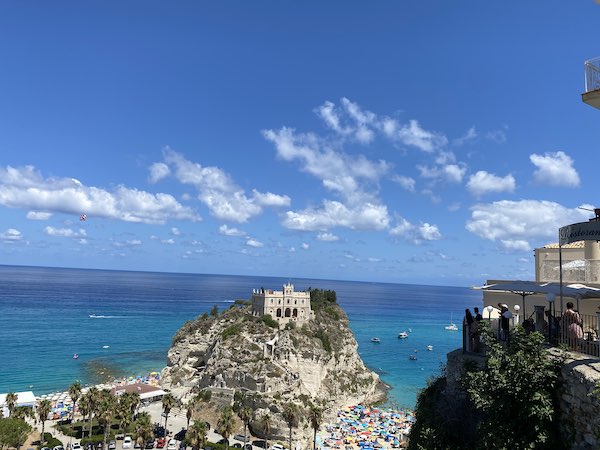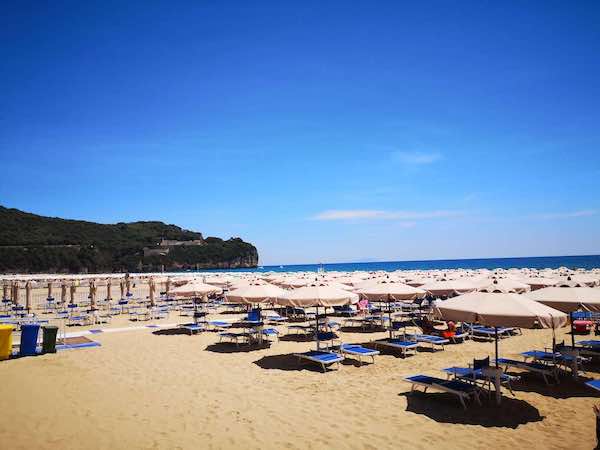
Ferragosto, August 15 in Italy: all you need to know
All you need to know about Ferragosto in Italy: what is it and what to expect as a tourist. Learn what Ferragosto means in Italian, the origin of the name and the main traditions around Ferragosto in Italy.
If you’re planning a trip to Italy in August, chances are you have come across the word ‘Ferragosto’, often accompanied by comments along the line of: ‘It will be Ferragosto, all will be shut!’ or “Ferragosto, it will be the busiest time’.
If you have never come across Ferragosto before, these sentences can be very worrying: it is even worth going to Italy at Ferragosto is all all is shut and all is busy? Let me help take the worry away!
I am Italian and have spent most of my Ferragostos in Italy. And I can tell you this: no, not everything shuts down but yes, some things do. And yes Italy is busy then but not everywhere. So, like it often happens, reality is a more nuanced than most of the web suggest!
In this guide, I explain what ferragosto is and how it usually affects Italy and, potentially, you as a visitor.
I hope it is useful!
What is ferragosto?
Ferragosto is a festivity that falls on the 15th of August and national holiday in Italy.
The day celebrated the Assumptions of Mary and is, at present, a religious holiday (read below about its history, there is more to it!)
Ferragosto is national holiday in Italy and since it falls in the middle of the summer, it is a time when Italians go on vacation: offices tend to close for the summer break, schools are still out and people leave the cities to take a summer break on the coast, mountains or abroad.
This exodus from the cities to holiday areas has effects on what it open and how you experience each location.
Let’s have a look at what to expect.
Is everything closed at Ferragosto in Italy?
The most common worry I hear about ferragosto in Italy is about closures and the answer is: no, it is absolutely not true that everything shuts in Italy mid-August!
August is very high tourism season in Italy and all coastal areas, mountains and vacation destinations are in full swing: hotels, tours, boat tours, restaurants, beaches – anything that has to do with tourism is operating in full force in August.

That said, some places do close.
In cities especially, public administrations and offices tend pack up for the two weeks around ferragosto (usually the one before and the one after, so the two middle weeks of August) and this means all services catering to locals slow down or even close.
In cities especially, you will have some restaurants and smaller shops closed for the break. You will however be able to visit most attractions and take tours.
Need to know: since the 15th of August is a catholic holiday, religious establishments such as the Vatican Museums are impacted by it. When planning a trip to big cities in Italy in August, look specifically at opening days as on the 15th itself some things do shut for the day.
Do attractions close for Ferragosto
In Italy, attractions operate independently one from the other so there is no such things as everythign being open or everything being closes.
When planning a trip to Italy around a national holiday such as this one, it is paramount to check the opening days /hours of each attractions not to be cough out.
You can find here >>> all the official and booking sites for the most famous attractions in Italy.
Do trains stop for ferragosto
Trains do not stop for ferragosto. However I have noticed in the past the exact schedule for the festive days often comes out later than others so it may take a bit of patience and wait until closer to the time to finalise plans.
Do shops close in Ferragosto?
Ferragosto can affect the opening hours of shops. Since local demand is lower at this time, many shops close either for the full 2 week break or observe shorter opening hours on the day of the 15th.
In big cities you’ll always find supermarkets open but they may not be your local one: I recommend not relying on getting essentials that day and stock up before, especially if you are new to a city and may not know where to go.
In vacation destinations shops tend to stay open since these are the places where people are.
Do restaurants close for ferragosto?
it depends. Some restaurants close for ferragosto and some do not. In cities, following the principle above of low demand, you’ll find many establishments do close while in holidays destinations things including restaurants will be in full swing.
Is ferragosto busy in Italy?
How busy ferragosto in Italy is depends on where in Italy we are talking about.
Ferragosto in Italy is the busiest time on the coast, on the mountains and country stays. It is however relatively quiet in the cities since locals tend to leave and tourists tend to avoid this time due to the often excessive heat.
So, How to plan for ferragosto in Italy?
All this considered, the main things to keep in mind when planning are:
>>> Check each attraction website to make sure they are open on the 15th so you can plan your itinerary accordingly
>>> Expect high crowds / high prices in all vacation spots in Italy
>>> Expect Italian big cities to be at their quietest in terms of local life, this is a time when you’ll mostly meat tourists. This has some advantage as often places like Rome and Venice are very quiet at this time, ferragosto is not all bad news!
>>> Expect some restaurants and shops in big cities to be closed
What is the meaning of Ferragosto in Italian?
Ferragosto is the name of the Italian festivity celebrated on the 15th of August and, by extension, the word Italian use to talk about the 15th of August and the days off around it.
Ferragosto is traditionally a day of rest and a time when people leave the city to get relief from the heath, meet friends and be jolly.
It is traditional, on the day of Ferragosto, to have BBQ, bonfires, beach parties and generically large gatherings with friends and family.
Need to know! While large celebrations with grills and open fires are traditional, they are a huge hazard at a time like this when large gatherings and wildfires are a threat to public safety. Make sure you enjoy Ferragosto responsibly and always abide by current regulations. Fire and gathering warnings are in place – check local regulations before making any plans.
The origin of the term Ferragosto and it meaning
The origin of the term ‘Ferragosto’ seems to date from the I century AD.
In 18 BC, Octavianus Augustus is said to have established several festive days in the month of August, to mark a moment of pause for agricultural labor, exceptionally hard and unforgiving during this hot month.

Augustus’ celebrations involved horse races and chariot shoes and they were in line with more ancient local traditions that celebrated the ancient Roman God Consus right at this time, to mark the end of the agricultural work for the summer.
The month itself got names after him (Augustus > August / Agosto in Italian) and the celebrations he proclaimed took the name ‘Feriae Augusti’. Feria/feriae in Latin meant holiday/day off/celebration day when public office stopped; Augusti meant ‘of Augustus’).
At the time, the celebrations happened over several days and it seems the most important fell on the 1st of the month and then again on the 13th, effectively making the month of August one with several days of rest, courtesy of the Emperor.
This means that ferragosto, in origin, was a pagan festivity. However, things changed as Christianity spread across the Italian peninsula.
Starting from the VI century AD, we have documents stating that the 15th of August was celebrated by Christians as the day of the Virgin Mary’s Assumption into the sky.
According to Christian tradition, on this day Mary would have been lifted into the sky in the flesh: her assumption into the heaven anticipates the resurrection of the flesh that Christian tradition believes happens after the Last Judgement.
The first mention of this belief is found in the writing of Gregorius from Tours (VI century) and can be found in many writings from the Church’s Fathers.
The Assumption of Mary became dogma in the Catholic Church in 1950, when Pope Pius XII also set the day to mark this recurrence on the already traditional 15th of August.
Nowadays, in Italian, we refer to the 15th of August as Ferragosto or also L’Assunzione and the day is national Holidau.
In fascist times, the 13-14-15 August were marked with special discounts on transport that allowed even the poor to leave the city for one to three days. This helped to set the tradition of ferragosto as a day off and also as a day to leave the city.
Buon ferragosto meaning
On the 15th of August, it is common for Italians to say ‘Buon Ferragosto’ to each other. This is the standard way to wish each other a good day on this summer festivity.
‘Buon’ in Italian means good or, in expressions such as this one, ‘happy’ (like in Buon Compleanno – happy birthday in Italian).

Ponte di ferragosto meaning
You may hear the word ‘ferragosto’ as part of the expression ‘Ponte di Ferragosto.
Ponte in Italian means ‘bridge’ and the expression is used when the 15th of August falls on a Thursday or a Tuesday.
In this case, many Italians take the extra day off work, ‘bridging’ ferragosto to the nearest weekend, to have a longer holiday.
Ponte and ‘fare ponte’ are common expressions for the extra day off and the locution ‘di ferragosto’ simply defines which celebration you are talking about.
Ferie d’Agosto meaning
August is the traditional month for Italian to go on holiday. Schools are closed, public offices slow down and overall the country falls into a slower pace: for many professions (not all), August is considered downtime.
The vacations taken from work at this time are often referred to as ‘ferie d’Agosto’, August’s vacations, the ford ‘ferie’ in Italian meaning ‘days off work’.
Ferragosto celebrations in Italy
Ferragosto is celebrated privately pretty much anywhere in Italy but some areas have special events to mark this day. Among the most spectacular, it is worth mentioning: please note that most public events are not running in 2021 for public health reasons.
Palio di Siena, maybe the most internationally famous event of its kind, started in Siena probably in 1605 and still celebrated (current restrictions have it temporarily paused)
Giostra del Saracino in Sarteano, in Val d’Orcia, a celebration with medieval costumes and games
Processione della Vara (Messina), a procession happening in Messina with a celebratory chariot that is said to date back to 1535
Boat procession in Santa Maria di Leuca, during which a statue of the Virgin is carried around town and the to the port, where it boards a highly decorated boat, then carried into the sea and then back into town.
Palo della cuccagna, an event happening in many towns, with participants climbing a tall pole on the central square
Caccia al Cinchiale in Mondavio, when you have three days of celebration with fireworks and renaissance style festivals
Even if you cannot join any of these events, you are likely to see parties and celebrations especially in vacation towns popular with Italian tourists. They can be great fun!




